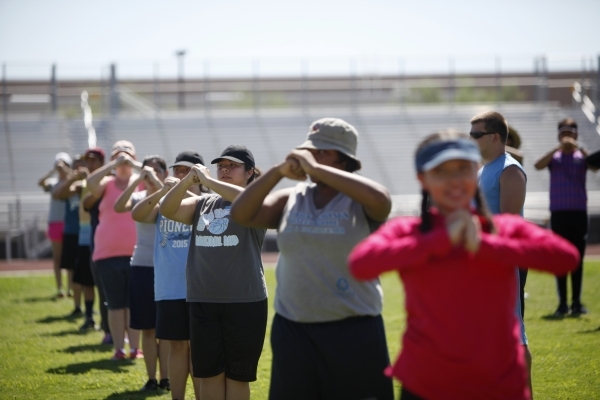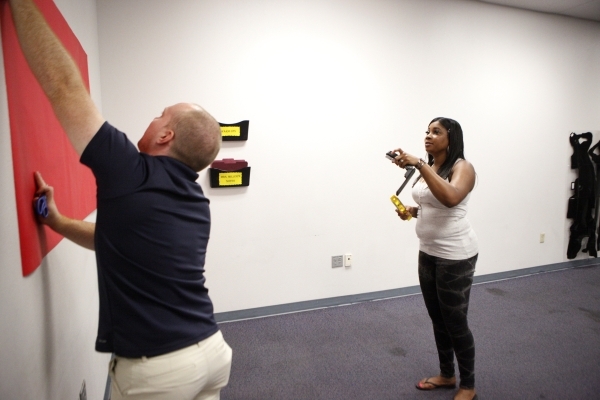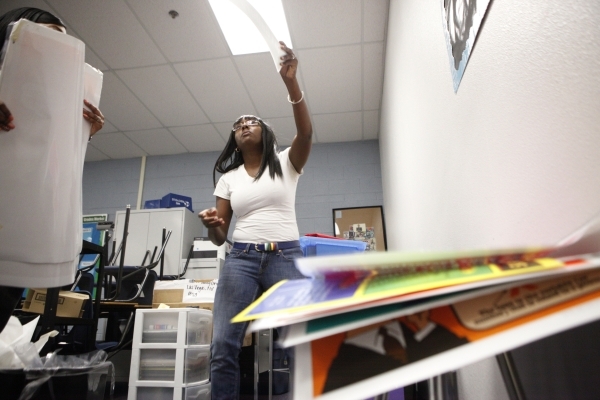Northern-area schools: Serving a diverse student population






Schools have the power to merge students of all races and economic backgrounds and provide equal education to all. Inside these educational facilities, young minds are being trained to create scientists, politicians and teachers.
Regardless of where the student comes from, schools can help bridge the gap to the American Dream.
But are schools really the great equalizer?
“The population in this 2-mile stretch there between Legacy High School, Mojave High School and Canyon Springs High School may be similar, but the students’ needs are so diverse,” said Zach Hartley, director of bands and department chair over the fine performing arts at Mojave High School, 5302 Goldfield St. “Las Vegas is such a diverse city. I understand the need to have a fair and balanced budget, but when you look at the needs of the students, fair isn’t necessarily equal.”
The Clark County School District is the fifth-largest school district in the nation, with more than 318,000 students. The school district budget for 2014-15 was $2.369 billion, and the basic per-pupil funding for the 2014-15 school year was $5,527, with per pupil expenditures at $8,059, according to ccsd.net.
“Funding for school sites is allocated the same for each school in the district. We do not make a distinction from a Summerlin school versus a school in North Las Vegas, for example, in terms of allocation,” a school district spokesperson said.
Clark County public schools are organized into zones that determine which school a student will attend. A student’s zone is assigned by where his parents reside.
Although students may apply to any select school’s magnet program regardless of their assigned zone, residential exclusion based on social hierarchy and class remains apparent.
“There are a lot of maps created to show that, overwhelmingly, the one- and two-star schools are in the core of Las Vegas and North Las Vegas,” said Dr. Joe Morgan, assistant professor of special education and coordinator of special education programs in the UNLV Department of Educational and Clinical Studies. “As you go out further into the valley, like in Summerlin or Centennial Hills, the star level increases. We know that in areas where there are one- or two-star schools, there is also a higher concentration of students living in poverty, students who are English learners or students with special needs.”
It is not only poverty that directly affects academic achievement; hunger and access to early education make a huge difference in a student’s success, he added.
“Schools with lower stars also have higher transient rates,” Morgan said. “We know that transiency is directly related to poverty. People tend to go to cheaper living areas.”
Students from lower-income areas are also typically taught by less experienced teachers.
“State data shows that the highest percentage of newly licensed and alternative licensed teachers are in urban schools because they have the highest need due to their long-term vacancies,” Morgan said.
The educational inequity can be further seen between Centennial Hills and North Las Vegas.
CENTENNIAL HILLS SCHOOLS
Thompson Elementary School, 7351 N. Campbell Road, has a four-star rating and ranks 38th among 210 elementary schools in Clark County, according to schooldigger.com, a website that contains detailed profiles for schools.
The teacher-to-student ratio varies depending on the grade level, said the school’s principal, Shawn Halland. Typically, younger grades have 23 students to a classroom and fourth and fifth grade have 32 students, he added.
The student population is approximately 35 percent white, 20 percent black, 20 percent Hispanic, 15 percent multiethnic and 10 percent Asian or Pacific Islander, according to Halland.
Now in its 10th year, the school has approximately 50 licensed teachers who range from having 25 years of experience to first-year teachers, Halland said.
In addition, 38 percent of the students qualify for the free and reduced lunch program, and the school has an average district transient rate of 28.7 percent, according to Halland.
“We’re pretty much typical,” Halland said. “The only challenge we’re really having is that we’re in a period of growth. Two years ago we had 700 students; now we have over 800. This is a challenge that most schools right now are facing.”
Principal Trent Day of Centennial High School, 10200 W. Centennial Parkway, said although the school had an 80.7 percent graduation rate last year, he feels that every school must learn to adapt to its community’s needs.
The school has a three-star rating and ranks 18th among 51 ranked high schools in Clark County, according to schooldigger.com.
“In today’s society, no matter what area kids live in, you will find some who are at risk,” Day said. “Schools have been impacted since the recession, which caused the displacement of families. There are a lot of socioeconomic issues that need to be taken into consideration.”
NORTH LAS VEGAS SCHOOLS
Duncan Elementary School, 250 Rome Road, was one of the last new schools to open in 2010.
Since the school is relatively new it has not been ranked on schooldigger.com.
The classroom size varies according to grade.
Principal Rick DiTondo estimates that there are roughly 21 students in kindergarten, 19 students in first and second grade, 22 students in third grade and 32 students in fourth and fifth grade.
Although textbooks are readily available, DiTondo said the school is trying to make the shift from becoming more student-centered and creating more hands-on activities.
“We have teachers with 20 years of experience, teachers who are brand new and everything in between,” DiTondo said. “Quite honestly, I kind of like it. The 20-year veteran will have tried and true ways to do things, and the brand new teacher may be able to make better connections with students.”
In the school where 20 percent to 25 percent of students are Caucasian, 30 percent are Hispanic and 30 percent are black, DiTondo said the school’s surrounding ZIP codes were among the hardest hit during the recession.
“We have over a 50 percent transient student rate,” DiTondo said. “We have parents who are medical professionals, some who are in the Air Force and others who come to us from section 8 housing. There’s a lot of turnover here.”
Canyon Springs High School, 350 E. Alexander Road, is in its transitional year of being a Turnaround School.
It has a one-star rating and ranks 40th among 51 ranked high schools in Clark County, according to schooldigger.com.
The school has an average of 32 students per classroom with a mixture of 12 veteran teachers who opened the school more than 10 years ago and 24 probationary teachers, said the school’s principal, Ron Guerzon.
The Tier II school has a transient rate of approximately 40 percent.
Minorities account for 88 percent of students, and this year Guerzon predicts the graduation rate to be around 67 percent.
“Every single school in the district has a big job,” Guerzon said. “We all want to motivate our students to graduate and succeed in life. Here we’ve been moving towards iPads for the past three years. We have an abundance of Kindles, iPads, eBooks and laptops. They do an excellent job of increasing student engagement.”
Mojave High School is classified as a Turnaround School.
Turnaround Schools are those that have chronically underperformed and are in need of a renewed focus that emphasizes helping students achieve and grow, according to the website ccsdturnaroundzone.net.
The high school, built in 1996, has a one-star rating and ranks 18th among 51 high schools in Clark County, according to schooldigger.com.
On average, the classrooms hold 30 students, and most teachers have three to seven years of experience, according to principal Antonia Rael.
With 90 percent minority students, approximately 73 percent qualify for the free or reduced lunch program at Mojave. The 2013-2014 graduation rate was 61 percent.
“Our challenge is that we have a high transient rate at 33 percent,” Rael said. “The student population changes by one-third every year. It’s the nature of our community. We have a highly mobile community with a lot of rental properties and apartments in the zone. “
To keep up with the times, the school is also slowly transitioning to iPads. Rael said the school has 600 iPads that can be used during instructional time, but dividing them among 2,300 students can be a challenge.
So, are there noticeable educational disparities?
“I think there are,” Rael said. “One challenge is that we deal with students that come from homes of greater poverty. They need more financial resources than more affluent schools to educate them properly. Being funded the same is actually an inequity. Schools like these need additional support. We have Title I funding, but it’s not always enough.”
To qualify for Title I funding, schools must have at least 40 percent of their student body in the free or reduced-price lunch program. Title I schools can receive additional per-pupil funding to help students from low-income families.
Hartley agrees.
“For a lot of students, their challenge lies at home,” Hartley said. “I have a handful of students that work part-time jobs to support their family and others who help take care of their younger sibling while their parents work a late shift. The traditional school setting is not made for everyone.”
— To reach North View reporter Sandy Lopez, email slopez@viewnews.com or call 702-383-4686. Find her on Twitter: @JournalismSandy.












